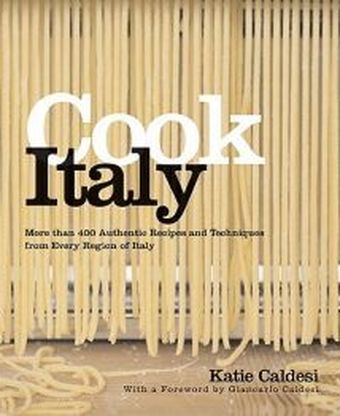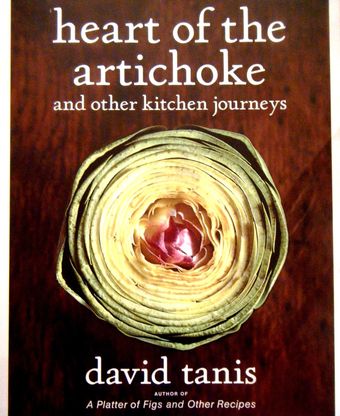This is something of an unfair fight.
Katie Caldesi's Cook Italy is an attempt to introduce cooks to the full range of Italian food, and tries to be a comprehensive guide to both the country and its food. The author fell in love with both an Italian and Italy -- she's not the first to do both at the same time -- and now runs two restaurants with her husband and, more to the point for this book, cooking schools in both England and (in the summer) Italy.
Caldesi understands both Italy and Italian food better than most Americans who try the subject: it's a factor of being closer than we are. She's also clear-eyed about the illusory joys of so many of our fantasies of living there.
Not spending all my time in Italy, I can dip in and out of its beauty without suffering the hardships of daily life. I don't see the unemployment, I don't have to deal with the often ridiculous bureaucracy, I cannot hear the provincial small-mindedness that I know exists. Instead, I dream that Giancarlo and I will live there one day, and I feel homesick for a land that is not my own.
Close as she and England can be to the source, as with all English cookbooks in the United States there's the false-friend problem. Ingredients look alike, the language sounds alike, but they're really not alike. The problem is notorious with baking, which never really translates because of the necessary precision and differences in flour milling and protein content, water in the butter, and the like.
But even if mammas (the usual hazard with of falling in love with Italians) approximate everything anyway, this tendency is a problem with Italian food, too, especially when it comes from chefs -- as many of the recipes in Caldesi's book do. She aims to make this a cooking school, and calls numerous sections "masterclass," but trying to get every part of Italian food, and every part of the country, into one heavy picture book means necessary vagueness and omissions that can trip up novices. If you want to make Neapolitan baked pasta, for example, because the author calls it "probably the best dish I have ever eaten," you'll need to decide whether or not to drain the 2 1/2-pound can of plum tomatoes when making the base sauce (yes), what temperature to boil eggs at (mighty low for 8 minutes, I'd say), and how al dente to cook pasta and fry little meatballs when you're going to bake them for a half hour. Two interesting recipes for goat, the meat of the moment, require experience and finding lardo as a base (a good idea) not to mention goat spleen, heart and liver "if available."
The "masterclass" sections can leave you with more questions than answers, especially with the grainy, dark black-and-white thumbnails that don't answer many questions about, say, how to prepare squid. But there are plenty of good tips within them nonetheless, for instance the advice to scale a fish under running water, "otherwise the scales 'ping' around the room!'" All Caldesi's basic notes on preparing fresh fish, in fact, are sensible and helpful. And I'm interested in her advice to freeze gnocchi before cooking them, because "they tend to hold their shape better."
For all its ambition and comprehensive view of eating in Italy, this is much more a book to look at than to cook from. And it's great to look at: full of page-sized color pictures on heavy stock of attractive food being made and eaten by attractive people.
David Tanis's Heart of the Artichoke is a whole different animal: a relatively skimpy collection of menus grouped by season. There's practically nothing in it by comparison: white space all over the pages, text that's almost entirely personal rather than explicitly instructional, straightforward layout with no sidebars.
The difference is that all the recipes were tested in American kitchens, even if the author lives half the year in Paris and has based many of his recipes on his travels around Europe. And that I love his sensibility, honed by the decades he has spent cooking at Chez Panisse, where he still cooks the other half of the year. And I want to make all of his recipes. See why it's an unfair fight?
Anyone who has cooked out of A Platter of Figs, Tanis's first book, knows this sensibility, and how beautifully his recipes work. Mostly it's because they have a purity of focus, as well as a plain-spoken grace of expression in instructions that are never excessive but never, unlike much of Caldesi (I didn't draw the lines of this comparison, they did!), leave you wondering if some important step or piece of information got left out.
And okay, a point of direct comparison: there's a page called "It's not so hard to clean a squid," with an unexpected technique ("The key is never putting down the knife...and using the left hand to maneuver the squid"), absolutely clear and direct writing ("grab the tip of the cellophane-like quill at the top of the body") and three largish, clear pictures.
There isn't anything like the scope or one-country concentration of Cook Italy here. Tanis ranges widely, hitting on Vietnamese pho, pita with za'atar and olive oil, tea-smoked chicken salad, and plenty of French and Italian dishes. And a French-Italian one that right away caught my eye: chard and ricotta tart, which I fell in love with in Nice (where it's the unappealingly named tarte aux blettes) and have had variations of in Liguria. The filling is the familiar Italian combination of ricotta, pine nuts, and raisins, which are mixed with cooked chard leaves to make what could be a filling for ravioli but is instead encased in a pate brisée -- with the Italian addition of baking powder in the dough, which lightens it and makes it puff a bit.
And then there's a sophisticated take on a simple dish I love and will eat in just about any variation: deviled eggs. But how much nicer to have them enriched with sour cream of or creme fraiche rather than Hellman's, and with the luxury of crabmeat. Dijon and a generous pinch of cayenne, juice of half a lemon, and nothing else.
Tanis snips chopped chives over his before serving, holding to just what will go well with the egg and crabmeat. But sorry! I had to sprinkle on some paprika. Tanis would approve: as he says in his introduction, "A recipe is a guide, not a formula." And it's a guide I want to use for the rest of this year and into the next.



5 Comments